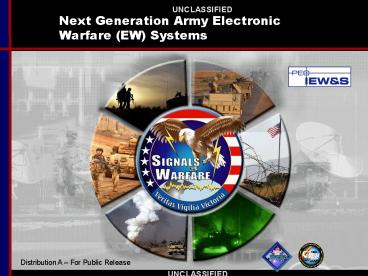Next Generation Army Electronic Warfare EW Systems - PowerPoint PPT Presentation
1 / 13
Title:
Next Generation Army Electronic Warfare EW Systems
Description:
Next Generation EW System Vision. Multifunctional, Reprogrammable, Reconfigurable, Integrated, Highly ... Open allows anyone to develop capabilities and add-ons ... – PowerPoint PPT presentation
Number of Views:4548
Avg rating:5.0/5.0
Title: Next Generation Army Electronic Warfare EW Systems
1
Next Generation Army Electronic Warfare (EW)
Systems
Distribution A For Public Release
2
THE OVERALL CLASSIFICATION OF THIS BRIEFING IS
UNCLASSIFIED
3
Next Generation EW System Vision
- Multifunctional, Reprogrammable, Reconfigurable,
Integrated, Highly Adaptive - Address all classes of threats with one common
platform - Provide feedback on effectiveness to operator
Battle Damage Assessment (BDA) - Low-RF signature minimize probability of
detection - Small footprint minimize number of operators,
antennas, and the size, weight, and prime power
requirements of the hardware platform - Ability to rapidly upgrade software and add
hardware to handle new threats - Minimize electronic fratricide
4
Granularity
Disrupt based on identity or characteristic
ONE
- Disrupting ONE, MANY, or ALL threat
communications may require - Threat survey capability
- Direction Finding and/or geolocation capability
- Exploitation of threat communications protocol
layers - Intelligence from other sources
- Reactive and active capabilities
ID
MANY
Disrupt based on geographic region, comms
network, class of threat, etc.
Disrupt all RF communications within Radio Line
of Sight (RLoS)
ALL
RLOS
5
Scalability and Configurability
- Scalability
- Seamless addition of hardware as threat quantity,
variety, and operating frequency increase - Seamless addition of platforms when an individual
platform cannot handle the load - Automatic synchronization of platforms for
cooperative attacks by dividing threats among
platforms or attacking a single threat from
multiple platforms - Leverage multiple platforms for geolocation
- Leverage EW system hardware for inter-platform
communication - Configurability
- Only those components required for the
application need to be purchased and deployed - Common Graphical User Interface (GUI) regardless
of configuration
6
Next Generation Integration
Rapid Integration of New Techniques
New Threat
Characterize Threat and Develop Techniques
Integrate with EW System
Assess Performance
- Minimize transmit time and power
- Simulation
- Laboratory testing
- Outdoor testing
- Software architecture framework
- Leverage integrated COTS components and products
- Adaptive resource management
with representative real-world threat
environment
7
Achieving the Vision
- Applying techniques that minimize transmit time
and power go a long way to achieving many of the
Next Generation Army EW system objectives - Facilitates addressing multiple threats and
threat classes within the same hardware platform - Lowers RF signature making the system more
difficult to detect and geolocate - Reduces RF power required to defeat threat thus
reducing size, weight, and prime power
requirements - Increases time available to conduct real-time BDA
- Reduces impact of Next Generation EW System on
Blue Force Communications
8
Minimize Transmit Power and Time
- Leverage ES to determine potential threat
frequencies prior to mission and update during
mission - Use reactive versus active techniques
- Exploit physical layer structure and higher layer
protocols to disrupt communications with minimal
transmission time - Attack just enough of the information content to
disrupt communications - Disrupt critical components and structures of
physical layer - Leverage threat communications protocol layers
9
Software Framework
- Open, layered, service-oriented architecture
- Open allows anyone to develop capabilities and
add-ons - Layering supports rapid insertion of new Digital
Signal Processing (DSP) / Digital Signal
Generating (DSG) platforms - Service-orientation facilitates modification of
some components without impacting others - Component-based integration framework
- Addition of capabilities achieved via
specialization of existing components (behavior
and interfaces) - Software development is at a higher level than
Application Programming Interface (API) /
Software Development Kit (SDK)
Minimize HW dependent code
Source Network Electronic Warfare Army
Technology Objective (ATO)
10
Hardware Framework
Card-Level Devices
- Anyone can develop hardware for the platform
- Components can easily be changed based on
changing threat or even mission
FPGA ADC
FPGA ADC
FPGA ADC
ICD/Interface
ICD/Interface
ICD/Interface
Power Amplifiers
Controller/GUI
ICD/Interface
Antennas
11
Scheduling
Mission Plan
Threat Type 1
- Challenges
- Multi-threat type / multi-mode / multi-band /
multi-focus - Dynamic and adaptive resource utilization
- Distributed resources
- Short implementation time scale
- Needs
- Resource discovery
- Resource monitoring / measurement
- Resource partitioning
- Task scheduling
Threat Type 2
Threat Type N
Scheduling
Environment
Source Network Electronic Warfare Army
Technology Objective (ATO)
12
Performance Assessment
- Testing Next Generation Army EW Systems will be
significantly more complicated than testing
todays systems - Diverse test environments with a sufficient
quantity and variety of threat devices that
dynamically adapt to jamming are required to
fully exercise next generation systems - A sufficient number of scenarios need to be
tested to ensure all Next Generation EW System
modes of operation are examined - Scalability and configurability are especially
challenging to test because of the limitation on
the number of scenarios that can be examined - Blue force communication systems need to be part
of the test environment to verify compatibility
under all modes of operation
13
Summary / Conclusions
- Must get away from Boxology Cant afford a
new box for every threat - Future EW systems will need a new paradigm
- Techniques that minimize transmit time and power
- Software framework that is adaptable to new
technologies, techniques and evolving COTS
hardware - Dynamic scheduling to maximize use of hardware
and deal with target rich and diverse
environments - Open platform specifications and tools are key
- Leverage SDR model
- Enable multiple vendors to implement techniques,
software and hardware

